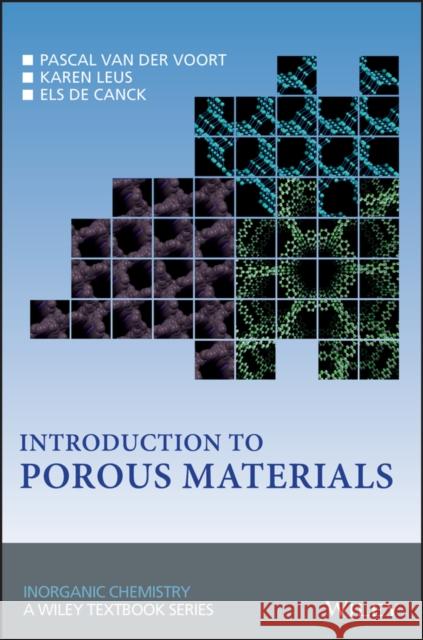Introduction to Porous Materials » książka



Introduction to Porous Materials
ISBN-13: 9781119426608 / Angielski / Twarda / 2019 / 448 str.
Introduction to Porous Materials
ISBN-13: 9781119426608 / Angielski / Twarda / 2019 / 448 str.
(netto: 438,96 VAT: 5%)
Najniższa cena z 30 dni: 457,13
ok. 30 dni roboczych.
Darmowa dostawa!
Wydanie ilustrowane
Preface xiAbout the Authors xiii1 Nature's Porous Materials: From Beautiful to Practical 11.1 Living Porosity 11.1.1 Butterflies 11.1.2 Algae 41.1.3 Bamboo 81.2 Clay Minerals 81.2.1 Natural Clays 81.2.2 Pillared Interlayered Clays - PILCs 12References 132 Theory of Adsorption and Catalysis: Surface Area and Porosity 152.1 Determination of Surface Area and Porosity by Gas Sorption 152.1.1 Introduction 152.1.2 Chemisorption and Physisorption 152.1.3 Reversible Monolayer Adsorption - The Langmuir Isotherm 162.2 The BET (Brunauer, Emmet, Teller) Model 212.2.1 The BET Equation 212.2.2 Multipoint BET Analysis 232.3 Capillary Condensation and Pore Size, the Type IV Isotherm 252.3.1 The Kelvin and the Halsey Equation 252.3.2 Barrett, Joyner, Halenda (BJH) Pore Size Distributions 272.3.3 Types of Adsorption Isotherms 322.3.4 Adsorption Hysteresis 342.3.5 Evaluation of Micropores 362.4 Liquid Phase Adsorption - Langmuir and Freundlich Isotherms 372.4.1 Adsorption Kinetics 382.4.2 Adsorption Isotherms 402.5 Heterogeneous Catalysis 422.5.1 Introduction 422.5.2 Types of Catalysis 442.5.3 Toward Green and Sustainable Industrial Chemistry 462.5.4 Kinetics in a Heterogeneous Catalytic Reaction 502.5.5 Diffusion Phenomena 572.A Appendix 66Exercises 68Answers to the Problems 71References 733 Zeolites and Zeotypes 753.1 Crystallographic Directions and Planes 753.1.1 Crystallographic Directions 753.1.2 Crystallographic Planes 773.2 X-Ray Diffraction 803.3 Zeolite Structures 823.4 Applications of Zeolites 853.4.1 Ion-Exchange, Water Softening 853.4.2 Catalysis 883.4.3 Gas Sorption and Purification 1093.5 Solid-State NMR 1113.5.1 Introduction to the Technique NMR 1113.5.2 Nuclear Magnetic Resonance: The Basics 1123.5.3 Solid-State NMR: The Challenges 1153.5.4 The Application of Solid-State NMR 118References 1184 Silica, A Simple Oxide - A Case Study for FT-IR Spectroscopy 1214.1 Different Methods to Synthesize Silica 1214.1.1 Silica Gels and Sols 1214.1.2 Pyrogenic Silicas 1264.1.3 Precipitated Silicas 1274.2 The Surface of Silica 1274.3 Fourier Transform Infrared Spectroscopy 1294.3.1 Principles of Infrared Spectroscopy 1304.3.2 Principles of FT-IR 1334.3.3 DRIFTS - Diffuse Reflectance Infrared Fourier Transform Spectroscopy 1384.3.4 Attenuated Total Reflection 140References 1425 Ordered Mesoporous Silica 1455.1 MCM-41 and MCM-48 - Revolution by the Mobil Oil Company 1455.1.1 The Original Papers and Patents 1455.1.2 Calculating the Wall Thickness 1505.1.3 Interaction Between Surfactant and Inorganic Precursor 1515.1.4 The Surfactant Packing Parameter 1545.1.5 Hexagonal Mesoporous Silica 1565.1.6 Stable Ordered Mesoporous Silica - SBA 1575.1.7 Plugged Hexagonal Templated Silica 1615.1.8 The New MCM-48: KIT-6 1635.1.9 Further Developments of Mesoporous Silica 1655.1.10 Pore Size Engineering 1675.1.11 Making Thin Films - The EISA Principle 1675.2 Applications of Mesoporous Silica 1685.2.1 In Heterogeneous Catalysis - Functionalization of Mesoporous Silica 1685.2.2 In Adsorption 1835.2.3 As a Drug Carrier 1885.2.4 Low-k Dielectrics 189References 1916 Carbons 1956.1 Activated Carbon 1956.2 General Introduction to Mesoporous Carbons 1976.2.1 Synthesis of Hard-Templated Mesoporous Carbons 1986.2.2 Synthesis of Soft-Templated Mesoporous Carbons 2046.2.3 Influence of Synthesis Conditions on the Soft-Templated Method 2076.2.4 Transformation of Polymer into Carbon, the Carbonization Temperature 2156.2.5 (Hydro)Thermal and Mechanical Stability 2166.3 Surface Modification of Mesoporous Polymers and Carbons 2176.3.1 Pre-Modification of Polymers/Carbons 2186.3.2 Post-Modification of Polymers/Carbons 2186.4 Nanocarbons 2186.4.1 Fullerenes 2196.4.2 Carbon Nanotubes 2246.5 Application of Porous Carbon-Based Materials 2276.5.1 The Adsorption of Pollutants 2276.5.2 As Catalytic Support or Direct Heterogeneous Catalyst 2316.5.3 Electrochemical Applications: Energy Storage 237Exercises 243Answers to the Problems 243References 2457 The Era of the Hybrids - Part 1: Periodic Mesoporous Organosilicas or PMOS 2497.1 Introduction 2497.2 Synthesis of PMOs 2537.2.1 General Aspects of PMO Synthesis 2537.2.2 PMOs with Aliphatic Bridges 2577.2.3 PMOs with Olefinic and Aromatic Bridges 2587.2.4 PMOs with Multi-Organic Bridges 2647.3 General Properties of PMOs 2657.3.1 Pore Size Engineering 2657.3.2 (Hydro)thermal and Chemical Stability 2677.3.3 Metamorphosis in PMOs 2697.4 Post-Modification of PMOs 2707.4.1 Post-Functionalization of the Unsaturated Bridges 2717.4.2 Post-Modification of the Aromatic Ring 2757.5 Applications of PMOs 2767.5.1 As Heterogeneous Catalysts 2767.5.2 As Adsorbents of Metals, Organic Compounds, and Gases 2907.5.3 As Solid Chromatographic Packing Materials 2947.5.4 As Low-k Films 2977.5.5 As Biomedical Supports 298Exercises 300Answers to the Problems 302References 3038 Era of the Hybrids - Part 2: Metal-Organic Frameworks 3098.1 Introduction 3098.2 Isoreticular Synthesis 3128.3 Well-Known MOFs 3138.3.1 Cu-BTC 3148.3.2 MIL-53 3148.3.3 MIL-101 3158.3.4 UiO-66 3158.3.5 NU-1000 3178.3.6 ZIF-8 3188.4 Stability of MOFs 3188.5 Preparation of MOFs 3208.5.1 Hydro- and Solvothermal Synthesis 3208.5.2 Microwave-Assisted Synthesis 3208.5.3 Electrochemical Synthesis Route 3218.5.4 High-Throughput Analysis 3218.6 Functionalities in MOFs 3218.6.1 Active Sites in MOFs 3218.6.2 Multifunctional MOFs 3228.7 Applications of MOFs 3328.7.1 MOFs in Gas Storage and Gas Separation 3328.7.2 MOFs in Catalysis 3518.7.3 Luminescent MOFs 3558.8 Industrial Applications of MOFs 3648.9 Transmission Electron Microscopy 3668.9.1 Electron Diffraction and Bright Field Imaging 3678.9.2 High-Resolution Transmission Electron Microscopy 3688.9.3 Scanning Transmission Electron Microscopy 3698.9.4 Energy Dispersive X-Ray Spectroscopy 3718.9.5 Electron Energy Loss Spectroscopy 3718.9.6 Electron Tomography 371Exercises 372Answers to the Problems 374References 3779 Beyond the Hybrids - Covalent Organic Frameworks 3819.1 Classification and Nature of COFs 3819.2 Design of COFs 3839.3 Boron-Based COFs 3869.3.1 Introduction 3869.3.2 Other Synthetic Routes to Obtain Boron-Based COFs 3899.3.3 Methods to Increase the Stability of Boron-Based COFs 3919.3.4 Applications of Boron-Containing COFs 3929.4 Covalent Triazine Frameworks 3959.4.1 Ionothermal Synthesis of Covalent Triazine Frameworks 3959.4.2 Acid Assisted Synthesis Route 3989.4.3 Mechanochemical Synthesis 3989.4.4 Applications of CTFs 3999.5 Imine COFs 4049.5.1 Solvothermal Synthesis: COF-300 4049.5.2 Room Temperature Synthesis of Imine COFs 4069.5.3 Liquid Assisted Grinding 4079.5.4 Applications of Imine COFs 408Exercises 414Answers to the Problems 415References 417Index 419
PASCAL VAN DER VOORT Center for Ordered Materials, Organometallics & Catalysis, Department of Chemistry, Ghent University, BelgiumKAREN LEUS Center for Ordered Materials, Organometallics & Catalysis, Department of Chemistry, Ghent University, BelgiumELS DE CANCK Recticel NV Insulation, Belgium
1997-2026 DolnySlask.com Agencja Internetowa
KrainaKsiazek.PL - Księgarnia Internetowa









